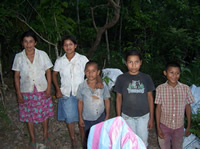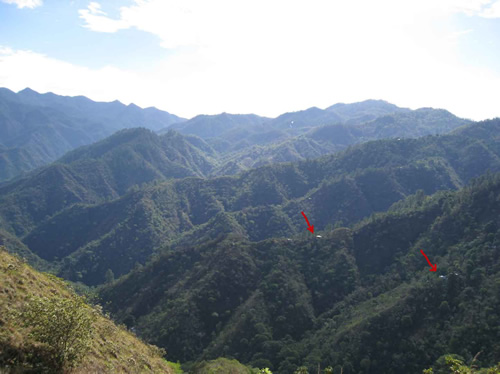Project Site
San Jose San Marcos de la Sierra is the central community of the Global Health Track's project site. San Jose is located in the southwest corner of Honduras in the Departmento (like a U.S. state) of Intibuca, in the county of San Marcos de la Sierra. The area is mountainous and undeveloped. The Hondurans refer to this part of the country as the Frontera (frontier) because it is so undeveloped. San Jose is a township composed of seven small villages: San Jose Centro, el Rancho, Guanacaste, Portillon, Potreros, Mangal, el Horno, and La Calera. The Rochester group first visited San Jose in 2004 and formalized the current collaboration in 2005. The San Jose residents were questioned about the main contributors to ill health. They rank ordered five main barriers to health.
- Lack of water (both quantity and quality) and sanitation.
- Inadequate nutrition
- Limited educational opportunities
- Health care
- Poverty is the foundation of the above problems
Based on this list of barriers to health, interventions have been and continue to be created to reduce their deleterious effects. Visit the following link to learn more about the interventions. Of note, our interventions have been so successful, our activities are expanding to villages surrounding the San Jose township.
Population

Lenca Indian family
Most people are from an indigenous group called the Lenca Indians. We estimate there are about 2,500 – 3,000 inhabitants in the San Jose township. A significant proportion of adults are illiterate and were unable to complete grade school.
Language
All people speak Spanish. The Lenca language is essentially extinct in the San Jose area.
Environment
San Jose is a dry mountainous area. Although the highest elevation of about 4,000 ft. in Rancho is not very high, the lowest point in La Calera at around 1,200 ft elevation gives a difference of almost 3,000 ft. There is very little flat land in San Jose. Walking anywhere is better described as hiking up and down steep hills. Most farming must be done on these steep hillsides. The rainy season starts in May and usually ends in October/November. San Jose residents must contend with no rain for six months. During the dry season, lack of water is one of the greatest problems San Jose residents face. Temperatures range from about 68 degrees F at night time in the rainy season to about 95 degrees F at day time in the dry season.

Red arrows show two nearest neighbors in mountainous Southwestern Honduras.
The concept of village is a bit different in San Jose than other places such as West Africa. There often is no center of the village and each house is generally quite a distance from its nearest neighbor, often more than 1/4 mile and sometimes more than 1 mile. This sparse house density can make some interventions such as piped water systems more challenging.
Employment
There are no factories or major industry in the area. The government is by far the largest employer with most of those jobs being in education and government functioning. Most San Jose residents create small farms where they grow corn, beans and squash. Fruit plants such as mango, banana, pineapple and coffee are also grown. The vast majority of the population cannot survive on what they grow. Therefore, almost every family must leave San Jose for 2-4 months a year and harvest coffee in other parts of Honduras and el Salvador. A fast working adult male can make about $6/day picking coffee. The other main source of money comes from remuneration from family living in the U.S. Although the relative may be in the U.S. as an illegal immigrant and being paid less than minimum wage, the money earned in the U.S. and sent back to Honduras makes the supported families some of the richest.
General Observations

Buena vista: A typical morning view from San Jose
San Jose is a beautiful community in a dry mountainous area. The people are quite reserved but capable of deep friendships once they trust you. People work very hard in difficult conditions. Poverty is the foundation for their ill health. The population is not self sufficient at this time and gets support from various governmental and non-governmental organizations. With that said, outside support, when available, does reduce the hardships of daily life.